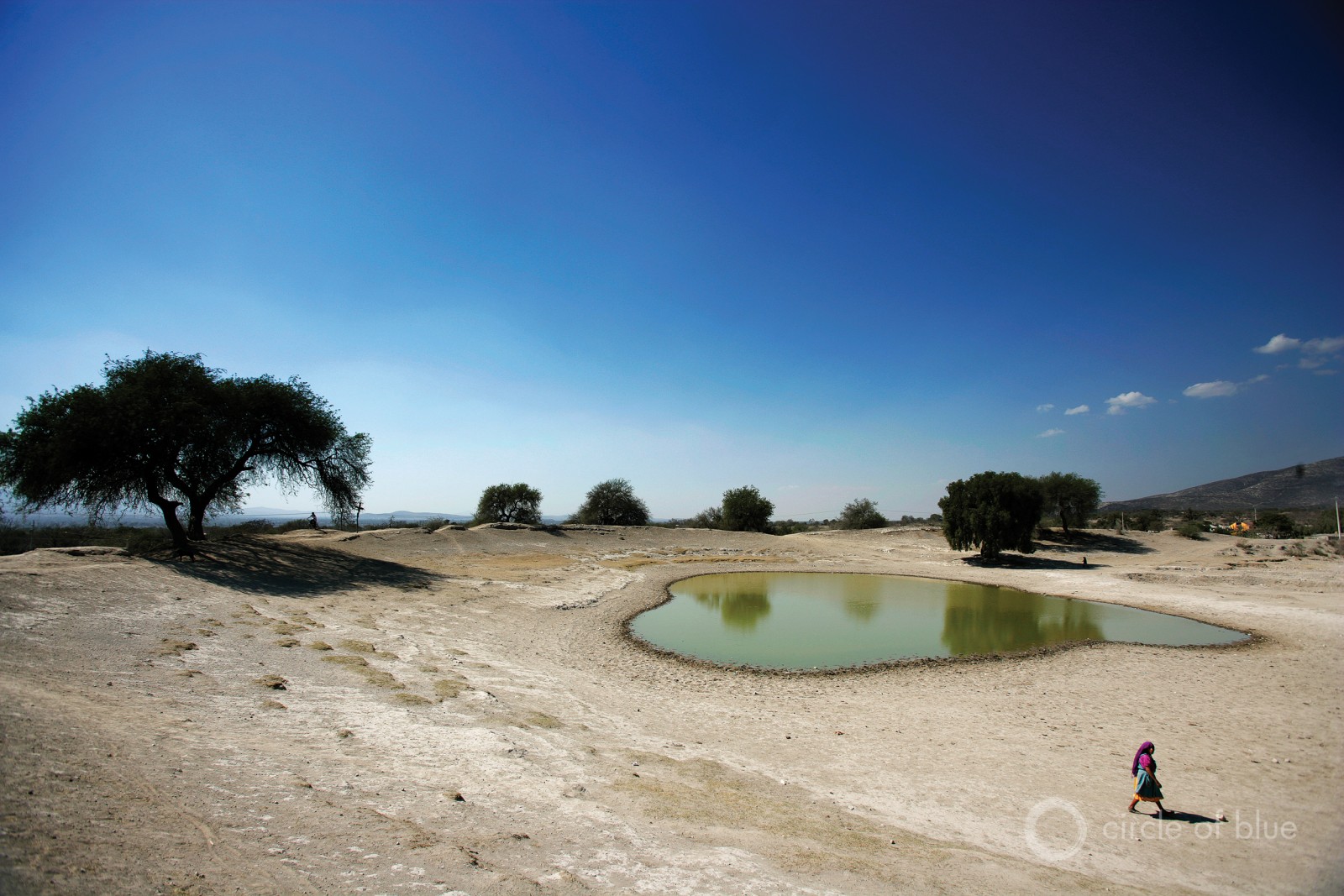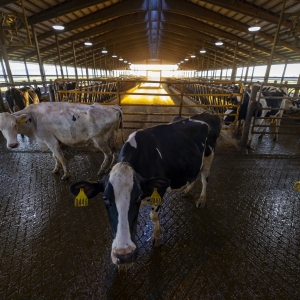The Stream, January 24, 2024: Lake Kivu, Between Rwanda and the Democratic Republic of the Congo, Is On the Verge of Erupting

A lone Mexican woman skirts a jaguey near San Marcos Tlacoyalco. These man-made, earth-bermed basins collect rainwater for livestock and also supply water for domestic needs. Photos © Brent Stirton / Reportage by Getty Images for Circle of Blue.
YOUR GLOBAL RUNDOWN
- Lake Kivu, which sits between Rwanda and the Democratic Republic of the Congo, has explosive potential, endangering wildlife and thousands of local people.
- Droughts caused by climate change in Brazil’s semi-arid northeast are negatively impacting the livelihoods of both small- and large-scale farmers.
- Information from 17 Russian field stations is no longer included in an international Arctic research network, limiting global study of the environment.
- Water shortages throughout Mexico are getting worse, and experts warn of high water stress for residents for years to come.
Water drawdowns at the Klamath River’s final three dams began last week, signaling the beginning of the end of the channel’s century-long blockages.
“The Klamath dams have been killing salmon and steelhead for more than a century. Starting next year, this will never happen again because the dams will be gone. For the Yurok Tribe, dam removal represents the restoration of our river, our traditional fishery, and our community, but more work needs to be done.” — Yurok fisheries department director Barry McCovey.
In November 2022, after decades of organizing and activism led by local Tribes — along with new federal regulations that would require an estimated $500 million in infrastructural improvements — energy company PacifiCorp announced that it would begin the drawdown and demolition of its four remaining hydroelectric dams on the Klamath River.
For over a century, the river — which flows for more than 250 miles through northern California and southern Oregon — has had its channels blocked by dams, impeding the passage of sacred salmon and other fish. The region’s “Salmon People” — who include the Yurok, Karuk, Shasta, Klamath and Hoopa Valley Tribes — rely on the fish as a subsistence food, and have had their relationship with the fish disrupted for decades.
As much as 80 percent more Chinook salmon could return to the Klamath River basin in the next 30 years, and ocean salmon harvests could increase by up to 46 percent, NPR reports.
One dam, the smallest, has already been removed. And last week, water drawdowns were facilitated at two more dams, while the third will be addressed later this month, Outdoor Life reports. By the end of the year, flows will return to the Klamath’s historic channel — the final step will be the removal of the obsolete dam infrastructure.
— Christian Thorsberg, Interim Stream Editor
Recent WaterNews from Circle of Blue
- “We Can’t Sit Back” – Amid Polluted Water and Climbing Cancer Rates, Iowa Eyes Farm Chemicals — Health authorities react to rampant fertilizer and pesticide contamination in water.
- The Year in Water, 2023 — Scenes from the Great Acceleration
The Lead
Located within a lush green valley, with Rwanda on its eastern shores and the Democratic Republic of the Congo to the west, Lake Kivu bubbles forebodingly. Under its surface, nearly 72 cubic miles of carbon dioxide, and 14 cubic miles of methane, are trapped.
Lake Kivu is one of three lakes in the world whose depths are marked by such high concentrations of the two gasses, a potentially explosive anomaly. The other two lakes have both already exploded — Lake Nyos in 1986 and Lake Monoun in 1984, both in Cameroon — killing thousands of people and animals.
Lake Kivu has yet to erupt — and the Rwandan government hopes to keep it that way. Officials have authorized a private company to remove methane from the lakebed, and convert the gas to energy. But researchers warn “that the effort might disturb the lake’s structure, triggering the very eruption it means to prevent,” National Geographic reports.
If Lake Kivu were to erupt, experts predict that between two and six gigatons of carbon would be released each day — a significant fraction of the 38 gigatons of carbon dioxide that are released globally each year. Anyone near the lake at the time of the eruption would surely die.
This Week’s Top Water Stories, Told In Numbers
30
Number of states, of Mexico’s 32 federal entities, that are facing water shortages, Mongabay reports. Stress is particularly high in Veracruz, where some residents receive tap water only twice per week as the local government rotates water rations throughout its capital city’s neighborhoods. On the off days, residents resort to buying water tanks, skipping showers, and postponing other daily tasks. According to the World Resources Institute, by 2050, between 40 and 80 percent of Mexico’s population will live with high water stress.
17
Number of Arctic research stations in Russia that have been barred from the international Arctic research network, alarming scientists who warn of an “increasingly biased view on Arctic change,” Yale Environment 360 reports. A recent study published in Nature examined 60 field stations within the network. Many were located in warmer, wetter climates, whereas the excluded Russian stations represented a significant portion of colder, drier data points. These data losses may severely limit researchers’ ability to monitor climate change in the Arctic.
On the Radar
Researchers say that droughts in Brazil’s semi-arid northeastern region — known as sertão — are accelerating desertification, Reuters reports. Nearly 2,000 square miles of local and large-scale farming are being affected, and the most severe effects are yet to come — within the next several years, the area affected by drought, caused by climate change, is expected to triple.
More Water News
San Diego: Rains fell at a rate of half-an-inch per hour in the southern California city as flash floods crushed cars and destroyed homes. The fourth-wettest day on record in the city prompted a state of emergency, Reuters reports.
Swedish Skiing: To weather-proof the country’s sporting pastime, concrete ski tunnels — kept cool by underground pipes protected by permafrost — have been built in the town of Torsby, BBC reports.
Christian Thorsberg is an environmental writer from Chicago. He is passionate about climate and cultural phenomena that often appear slow or invisible, and he examines these themes in his journalism, poetry, and fiction.







Leave a Reply
Want to join the discussion?Feel free to contribute!